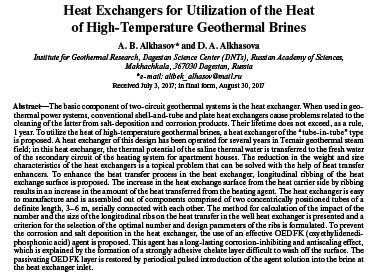The basic component of two-circuit geothermal systems is the heat exchanger. When used in geothermal power systems. conventional shell-and-tube and plate heat exchangers cause problems related to the cleaning of the latter from salt-deposition and corrosion products. Their lifetime does not exceed. as a rule. 1 year. To utilize the heat of high-temperature geothermal brines. a heat exchanger of the “tube-in-tube“ type is proposed. A heat exchanger of this design has been operated for several years in Tern air geothermal steam field. in this heat exchanger. the thermal potential of the saline thermal water is transferred to the fresh water of the secondary circuit of the heating system for apartment houses. The reduction in the weight and size characteristics of the heat exchangers is a topical problem that can be solved with the help of heat transfer enhancers. To enhance the heat transfer process in the heat exchanger. longitudinal ribbing of the heat exchange surface is proposed. The increase in the heat exchange surface from the heat carrier side by ribbing results in an increase in the amount of the heat transferred from the heating agent. The heat exchanger is easy to manufacture and is assembled out of components comprised of two concentrically positioned tubes of a definite length. 3–6 m. serially connected with each other. The method for calculation of the impact of the number and the size of the longitudinal ribs on the heat transfer in the well heat exchanger is presented and a criterion for the selection of the optimal number and design parameters of the ribs is formulated. To prevent the corrosion and salt deposition in the heat exchanger. the use of an effective OEDFK (oxyethylidenedi-phosphonic acid) agent is proposed. This agent has a long-lasting corrosion-inhibiting and antiscaling effect. which is explained by the formation of a strongly adhesive chelate layer difficult to wash off the surface. The passivating OEDFK layer is restored by periodical pulsed introduction of the agent solution into the brine at the heat exchanger inlet.
 Iran Energy News Oil, Gas, Petrochemical and Energy Field Specialized Channel
Iran Energy News Oil, Gas, Petrochemical and Energy Field Specialized Channel




